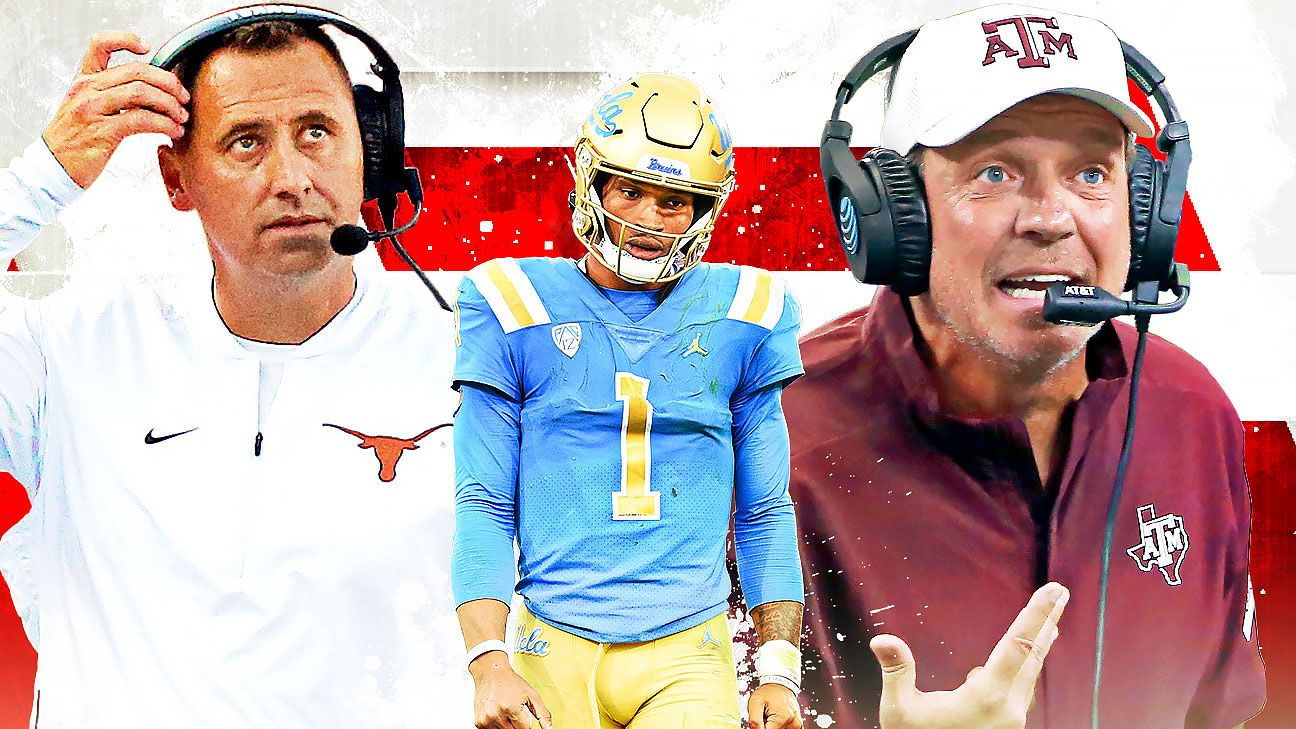Texas A&M fans, I’m ready for you.
I recognize it’s never fun for fans to see their team headlining college football’s underachiever tiers. Texas A&M has one of the largest and most prideful fan bases in the sport, so much so that it is synonymous with a number, 12. And although the home of the 12th Man was an easy pick to lead off the tiers, the truth about a team’s lack of performance can sting.
Bring on the backlash.
But before you do, hear me out. Last year, Georgia topped the underachiever tiers. Georgia was, in fact, the inspiration for the list. The Bulldogs had not won a national championship in my lifetime despite incredible advantages with resources and location. Behind a historically elite defense, Georgia went on to capture its first title since 1980. Perhaps Texas A&M, which has an even longer drought without a national championship, soon can surge all the way to the top. The most recent recruiting cycle suggests it’s possible.
Our goal is to identify programs that can’t break through despite plenty of pathways to success. For the most part, the teams aren’t hamstrung by location, fan and donor support, facilities, administrative commitment or team history. But for various reasons, the results don’t add up.
Not every team listed below should realistically contend for national championships. Some aren’t set up to compete for league titles or major bowl games very often. But there are sets of teams throughout the sport that should be reaching higher levels.
To maintain consistency from the first edition, I’ve identified six tiers of underachievers, focusing on results from the past 40 seasons (1982 to 2021) but placing greater emphasis on the most recent 15 to 20 years. Teams that have made the College Football Playoff are exempt, so Michigan is off the hook after its breakthrough last fall. I’ve also excluded any team that has won the national title in the past 15 seasons (2006 to 2021).
Several teams that appeared in last year’s rundown are listed, although information has been updated. Teams cannot appear in multiple tiers.
Let’s get started.
Tier I: Angst in Aggieland

A year ago, Texas A&M shared the second tier with UCLA and Texas, but in terms of long-term underachievement, the Aggies were closer to Georgia. The 2021 season didn’t help the team’s reputation. Coming off a No. 4 finish in 2020, Texas A&M entered the fall ranked No. 6 but ended up 8-4, an all-too familiar result. Other than an upset of No. 1 Alabama — Aggies coach Jimbo Fisher became the first ex-Nick Saban assistant to beat Saban — Texas A&M had a largely forgettable season.
Since 1994, when R.C. Slocum led Texas A&M to a 10-0-1 record and a No. 8 final ranking, the Aggies have lost four or more games 23 times. The team has two 11-win seasons and eight nine-win seasons during the span, including a 9-1 mark during the pandemic-shortened 2020 campaign. Conference play has been especially tough, as Texas A&M has at least three league losses in 20 of the past 23 seasons. The biggest mark against the Texas A&M program is a lack of championships — none in the SEC (league or division) and only one in the Big 12, coming nearly a quarter century ago in 1998, when Slocum still coached the Aggies. The most damaging demerit for Texas A&M is zero national championships since 1939. Since then, plenty of programs with fewer resources and natural luxuries — Maryland, Syracuse, Michigan State, Pitt, BYU and Colorado, to name some — have achieved what continues to elude the Aggies.
Texas A&M seems to have it all: a massive and dedicated fan base, deep-pocketed donors, sparkling facilities and a location in southeast Texas with prime access to Houston and other fertile recruiting grounds. Texas A&M spent nearly $485 million to renovate Kyle Field, gave Fisher a $75 million guaranteed contract and last fall announced a $205 million facilities plan for football and track. Few programs have as many celebrated traditions as the Aggies, from the 12th Man to the Midnight Yell. But those ingredients haven’t led to nearly enough notable on-field accomplishments. Texas A&M has produced great players, including 2012 Heisman Trophy winner Johnny Manziel, but hasn’t parlayed mini breakthroughs (2012, 2020) into sustained periods of success.
The good news is that the program seems to be close. Fisher hasn’t yet delivered on the 10-year contract he signed, and his four-year win total (34) is two shy of predecessor Kevin Sumlin’s (36) during Sumlin’s first four seasons. But Fisher just signed the nation’s top recruiting class, headlined by arguably the best haul of defensive line prospects ever. Texas A&M is flourishing in the name, image and likeness era. There’s stable leadership with Fisher and athletic director Ross Bjork, and money continues to pour in for program upgrades.
“There’s tremendous resources here,” Bjork told me earlier this year. “And not just money, but people and vision and research and the power of the Texas A&M brand. If we can get the alignment right in making sure that was set up in the right place, look, we can build buildings, we can make sure we have the right coaches, which means you can win games and win championships.”
Tier II: L.A. and the Longhorns

UCLA: This summer, one of my best friends married a woman whose uncle served as a UCLA assistant coach during the program’s last glory period. He told me all about the Terry Donahue-led Bruins and what it was like winning five Pac-10 titles, three Rose Bowls and a Fiesta Bowl between 1982 and 1993. UCLA had nine AP top-20 finishes and five top-10 finishes during the span. The program capitalized on its incredible location and excellent academic and overall athletic profile. Since then? Only two conference titles, none since 1998, and only one Rose Bowl appearance (none since 1998). UCLA has only three Top 25 finishes since 1998 and only one bowl appearance since 2015 (though last year’s team would have played if not for a COVID-19 outbreak). UCLA got lazy with its program and stopped investing, although the hiring of coach Chip Kelly and the construction of the Wasserman Football Center are significant changes. Still, the program has massively underachieved for a generation. Perhaps the upcoming move to the Big Ten will spark a program that enjoys many natural advantages.

USC: When a stunned Trojans team left the Rose Bowl field after falling to Vince Young and Texas in January 2006, no one thought the program would go 16 years (and counting) without a return to the national championship game. USC has been susceptible to underachievement — before coach Pete Carroll arrived after the 2000 season, the program went 65-52-1 with only two conference titles from 1991 to 2000. But the period since Carroll’s return to the NFL has been marred by poor leadership, overly insular thinking on key hires and utter dysfunction. USC won the Pac-12 and the Rose Bowl in 2016, and played for another league title in 2020, but the team has never seriously pushed for the CFP. No West Coast program comes close to matching USC’s tradition: 11 national titles, 39 conference titles and six Heisman Trophy winners. USC has direct access to a major recruiting hub in and around Los Angeles. The team made its splashiest coaching hire ever in Lincoln Riley, and finally has a solid athletic director in Mike Bohn. As the Big Ten transition looms, USC’s next step needs to be CFP appearances.

Texas: There’s a reason Texas still appears in rankings of college football’s best jobs. Texas boasts a distinct combination of immense resources, an appealing location in an emerging market and being the flagship school in one of the nation’s top talent-producing states. Texas is already showing its ability to capitalize on the name, image and likeness era. But every year seemingly casts more doubt on a program that can’t seem to get out of its own way. Texas hasn’t won a Big 12 title since 2009, played for only one league title since and boasts only one national title — in 2005, capped by an epic win over USC — since 1970. So while the recent issues are justifiably magnified, Texas’ inability to compete nationally for long stretches sticks out. The politics around the program are complex and difficult to navigate, even for skilled relationship builders such as former coach Mack Brown. But Texas still should never endure a stretch like the past 13 seasons, or others such as 1978 to 1993, when it had only two league titles. Texas had only one AP Top 25 finish in the decade from 1984 to 1993. Coach Steve Sarkisian had a good offseason after a tough debut, but Texas needs to start seeing more sustainedl progress before joining an even tougher conference in the SEC.
Tier III: Fading dynasties


Those of us drawn to college football in the 1980s and 1990s would never have predicted a time when Nebraska and Miami would largely vanish from the national radar (Florida State, too, although the Seminoles won the final BCS championship in 2013 and appeared in the first CFP in 2014). The Canes and Huskers were the sport’s defining programs for a generation. Miami won three national titles in the 1980s, Nebraska followed with three in the 1990s and Miami tacked on another in 2001 with arguably the most talented college team ever. From 1983 to 2003, the two teams combined for 27 AP top-10 finishes and 19 conference titles. Nebraska’s place as a college football heavyweight stretched back even further, as the program won back-to-back national titles in 1970 and 1971 and finished outside the top 10 just once during the 1970s. The Huskers finished no lower than 12th between 1970 and 1989, and then had only one finish outside the top eight between 1993 and 2001. Miami’s stretch of seven consecutive AP top-three finishes from 1986 to 1992 remains one of the most notable achievements in college football history.
Then, things got rocky. Not only have neither the Huskers nor the Canes won a national title since 2001, but neither has won a conference championship since 2003. (Nebraska’s last came in 1999.) Conference realignment hasn’t served either program well despite favorable division placements in the Big Ten West and ACC Coastal. Nebraska played for a Big Ten title in 2012 but hasn’t been back to Indianapolis since, as a revolving door at leadership positions repeatedly set back the program, mired in its worst stretch since the 1950s. The celebrated coaching hire of former great Scott Frost in December 2017 hasn’t produced a winning season. Miami has only one division championship (2017) in the ACC and boasts only four AP Top 25 finishes since 2005. While Nebraska has always faced talent-acquisition challenges with its location, Miami finds itself in one of the nation’s best recruiting hubs. Miami’s lukewarm institutional investment in football shifted dramatically late last year, as the program hired alum Mario Cristobal from Oregon and has sunk money into the program and its NIL appeal. The expectation in Coral Gables is conference titles and CFP appearances soon. Nebraska has a steeper climb in the Big Ten but should expect much, much better than what it has seen the past decade.
Tier IV: League title lulls
NC State, North Carolina, Minnesota, Ohio

NC State: NC State has not made a significant dent in the ACC during my lifetime. The Wolfpack last won the conference in 1979 and have yet to appear in the league title game despite rosters featuring quarterbacks Philip Rivers, Russell Wilson and Jacoby Brissett, and many other future NFL starters. Unlike some ACC schools, football matters at NC State, which has a solid fan base/game-day environment as well as good facilities. The region produces plenty of strong recruits, and talent really hasn’t been the issue at NC State, especially under current coach Dave Doeren. But NC State has had only four AP Top 25 finishes (zero top-10 finishes) in the past 28 years. The hype is building for this season with quarterback Devin Leary and others, and perhaps NC State can finally break through.

North Carolina: Like NC State, UNC has struggled to find sustained success in football despite obvious advantages over programs that have won the ACC more recently, including another area school, Wake Forest (2006). The Heels’ ACC title drought is only one year shorter than NC State’s, although the team at least reached the league title game in 2015. North Carolina is undoubtedly a basketball school first, but it also has a stronger overall athletics brand and institutional profile than most in the ACC. Mack Brown, whom the school brought back to lead the program at age 67 in 2018, is the only coach to record multiple AP top-10 finishes (1996, 1997) since Dick Crum in 1980 and 1981. Brown quickly brought back the buzz and UNC entered last season at No. 10, but familiar underachieving followed as the team stumbled to a 6-7 finish.

Minnesota: No one expects Minnesota to dominate nationally the way it did from 1934 to 1941, when the program captured five of its seven national titles. Geography works against the Gophers, even though the Minneapolis-St. Paul area produces plenty of FBS prospects. Until recently, Minnesota had not made all of the necessary investments in its program. Still, a Big Ten title drought that goes back to 1967 — Minnesota and Indiana shared the crown then, and neither has won it since — remains the Gophers’ biggest demerit. Their regional rivals Wisconsin and Iowa both have become consistent league title contenders, while programs such as Illinois, Northwestern and Purdue have won the league much more recently. Coach P.J. Fleck has the team on a promising path, especially after an 11-win season in 2019, but at some point Minnesota must end its title drought.

Ohio: The MAC is the league of opportunity, where almost any team can make a championship push in a given year. Except Ohio. Although the MAC is the only FBS conference in which every current member has won a championship, Ohio last captured a title back in 1968. The Bobcats dominated the MAC during the 1960s, winning four titles under coach Bill Hess. Since then, programs such as Toledo, Miami (Ohio), Central Michigan, Bowling Green and, most recently, Northern Illinois have piled up league titles. Ohio hasn’t been a bad program by any means, especially not in the past 25 years. Since 1996, the Bobcats have won six games or more 16 times. Coach Frank Solich guided the team to 11 bowl games between 2006 and 2019, and four MAC championship game appearances. But Ohio came up empty each time.
Tier V: Lacking spark in Group of 5
South Florida, Colorado State, Toledo

South Florida: A 21-win stretch from 2016 to 2017 feels like a long time ago, as South Florida has fallen off sharply since and, unlike I-4 rival UCF, did not make the cut for the Big 12’s recent expansion push. When the Big 12 studied expansion in 2016, UCF and USF were viewed somewhat through the same lens. Both occupied major markets in Florida and had achieved some high-level success. But since 2017, South Florida is just 14-32 with only three wins the past two seasons under coach Jeff Scott. South Florida is a relatively new program that doesn’t have an on-campus stadium, although facilities upgrades and other investments are on the way. Still, the Bulls’ location in recruit-heavy Tampa should prevent the program from enduring stretches like the past three seasons and a 9-27 run from 2012 to 2014. South Florida should be competing for AAC titles when UCF, Cincinnati and Houston move on to the Big 12.

Colorado State: To understand Colorado State’s position in the Mountain West pecking order, consider its most recent coaching hire. Jay Norvell left Nevada, which has made bowl games in 14 of the past 17 seasons but lagged behind its competitors in resources, for a Colorado State program that is 11-29 the past four seasons and has eclipsed seven wins just twice since 2002. Colorado State wants to win. A visit to Canvas Stadium will convince anyone of the team’s commitment to increasing its on-field profile. Although CSU must access other areas to fill its roster, it plays in a league that, other than the three California schools, must extend its recruiting reach. Maybe Colorado State never becomes Boise State or San Diego State, but it shouldn’t endure bowl-less lulls like the past four years and from 2006 to 2012, when the team made only one postseason appearance.

Toledo: The Rockets haven’t bottomed out like other capable Group of 5 programs. They haven’t had a losing season since 2009 and have made nine bowl appearances since 2010. Toledo appears here because it hasn’t reached the next level despite being positioned to do so in the MAC. The team has only one conference title (2017) since 2004 and, perhaps more disheartening, only one appearance in the MAC championship. Since 2005, Northern Illinois has five league titles, Central Michigan has three, Bowling Green and Miami (Ohio) have two and teams such as Buffalo, Ohio and Kent State have more frequently played for a league title. Toledo has a prime location in a midsized city, boasting good access to both the Ohio and Michigan recruiting markets. The school has solid administrative support. This is arguably the best job in the league. But since 2017, Toledo is just 17-13 in MAC play.
Tier VI: Just make a bowl game

Colorado: Colorado is moving further from its glory period, when the program won the 1990 national title and recorded eight consecutive AP Top 25 finishes between 1989 and 1996. The Buffs have finished in the AP rankings only once since 2002. No one expects Colorado, which has a challenging recruiting location and faced financial difficulties for years, to annually compete for the Pac-12 championship. Regular bowl appearances, on the other hand, are a reasonable expectation. Colorado has made necessary investments and reached the Pac-12 championship game in 2017. CU is a football school with a history of success and one of the best game-day settings in the country. But the team has made bowls just twice in the past 14 seasons. That should never happen in Boulder.

Rutgers: The Scarlet Knights were genuinely and justifiably excited when a Gator Bowl spot opened for them in December despite a 5-7 regular-season record. The team had not made a postseason appearance since the 2014 season, the longest drought of any Power 5 program. The bowl-eligibility bar has dipped lower than ever, and while Rutgers plays in the challenging Big Ten East, the near-reality of a seventh consecutive bowl-less season is deflating. Despite being located in an excellent talent-producing state, Rutgers has struggled mightily over the course of its history. Other than last year’s Gator Bowl and the 1978 Garden State Bowl, Rutgers’ bowl history is confined to a decade-long stretch, which began with Greg Schiano’s first stint as coach and continued under Kyle Flood. Rutgers made nine bowl games between 2005 and 2014. Replicating such consistency will be tough, but Rutgers shouldn’t endure long bowl lulls.

Arizona: Like Rutgers, Arizona has some baked-in challenges, including fewer resources than many Pac-12 programs and a limited history of success. Tucson is a mediocre location for recruits, and the program has to extend its reach to other areas. There are reasons Arizona has never reached a Rose Bowl despite joining the conference in 1978. But we’re not talking about Rose Bowls in this tier — any bowl appearance would lift the mood in Tucson. Arizona hasn’t made a bowl since 2017, coach Rich Rodriguez’s final season on the sideline. Since then, the team is 10-31. Although the Wildcats made eight bowls in 10 years from 2008 to 2017, they previously endured nine consecutive bowl-less seasons. The program will have a tough time recapturing the Dick Tomey glory days, but more regular postseason appearances should be a reasonable expectation.
